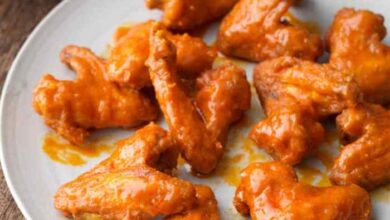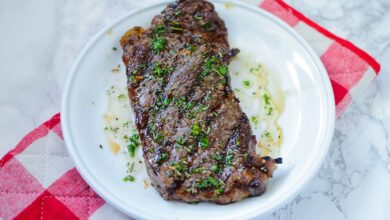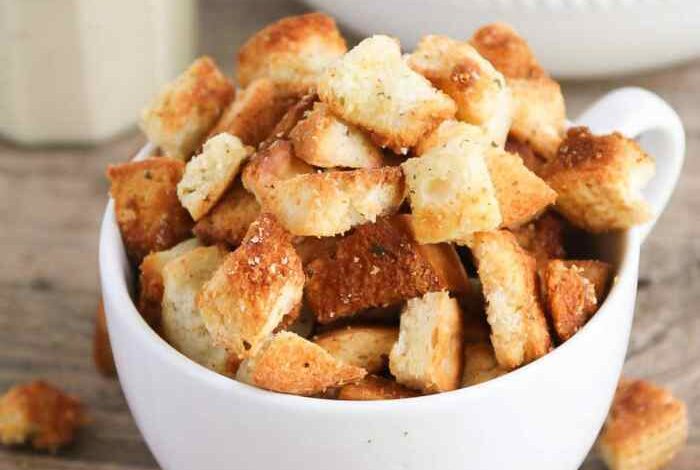
Old Hamburger Bun Croutons: A Deliciously Sustainable Snack
Old hamburger bun croutons: a culinary twist that turns leftover buns into a delightful and surprisingly versatile snack. This simple repurposing technique not only saves money but also reduces food waste, making it an eco-conscious choice. The key to success lies in the transformation process – drying and crisping the buns to achieve a satisfying crunch.
The result? Croutons that boast a unique texture and flavor, adding a delightful twist to salads, soups, and even desserts.
Beyond their culinary appeal, old hamburger bun croutons offer a sustainable approach to food management. By repurposing these often-discarded buns, we reduce our environmental impact and contribute to a more responsible food system.
The Appeal of Old Hamburger Bun Croutons
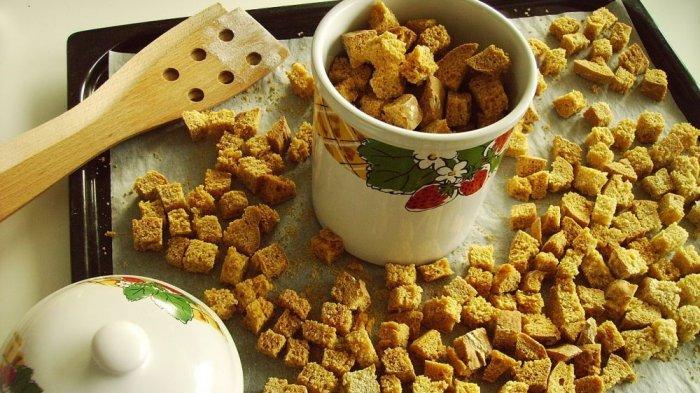
The idea of transforming leftover hamburger buns into crunchy croutons might seem unusual, but it’s a popular practice among many home cooks and even some restaurants. This clever repurposing technique not only helps reduce food waste but also adds a unique flavor and texture to salads, soups, and other dishes.
Reasons for Using Old Hamburger Buns
The choice to use old hamburger buns instead of fresh bread for croutons stems from several practical and flavor-related considerations.
- Availability:Old hamburger buns are often readily available, especially if you frequently enjoy hamburgers at home. This makes them a convenient and cost-effective option for croutons.
- Texture:The starchy nature of hamburger buns allows them to become delightfully crunchy when toasted. Their slightly denser texture holds up well in soups and salads, adding a satisfying textural contrast.
- Flavor:The subtle sweetness of hamburger buns, often enhanced by the presence of sesame seeds, adds a unique dimension to the flavor profile of croutons. This sweetness complements the savory notes of many dishes.
- Cost-Effectiveness:Using old hamburger buns for croutons is an economical way to use up leftover ingredients. It’s a great way to avoid wasting food and save money.
Texture and Flavor Comparisons
Croutons made from old hamburger buns have a distinct texture and flavor compared to those made from fresh bread.
- Texture:Croutons made from old hamburger buns tend to be slightly denser and more substantial than those made from fresh bread. This is due to the starchy nature of hamburger buns, which creates a more robust texture upon toasting. Fresh bread croutons, on the other hand, often have a lighter, airier texture.
- Flavor:The subtle sweetness of hamburger buns, often enhanced by the presence of sesame seeds, adds a unique dimension to the flavor profile of croutons. This sweetness complements the savory notes of many dishes. Croutons made from fresh bread typically have a more neutral flavor, which can be enhanced with herbs and spices.
I’ve been experimenting with different uses for old hamburger buns, and I’ve found that they make surprisingly delicious croutons! The slightly sweet flavor of the bun adds a unique touch to salads, and I especially love them in a fresh mozzarella pasta salad.
The creamy mozzarella and tangy dressing pair perfectly with the crunchy croutons, creating a satisfying contrast of textures and flavors. So next time you have some leftover hamburger buns, don’t throw them away! Give them a new life as croutons and see what culinary magic you can create.
Methods for Making Old Hamburger Bun Croutons
Transforming those stale hamburger buns into crispy, flavorful croutons is a culinary feat that’s both practical and delicious. Whether you’re looking to add a crunchy element to salads, soups, or even a breadcrumb topping for baked dishes, these croutons are a delightful way to repurpose leftover buns.
Cutting and Drying the Buns
The first step in creating these delectable croutons involves cutting and drying the buns. This process sets the stage for the perfect texture and ensures the croutons achieve their desired crispness.There are a couple of popular techniques for cutting the buns:
- Cubing:This classic method involves cutting the buns into small, even cubes. It’s a versatile option that works well for salads and soups, as the cubes readily absorb dressing or broth.
- Slicing:For a more rustic and visually appealing crouton, consider slicing the buns into thick rounds. This method is ideal for adding a textural contrast to salads or topping soups.
After cutting, it’s essential to dry the buns thoroughly. This step helps prevent soggy croutons and ensures they crisp up beautifully during the frying or baking process.
- Air Drying:This method involves spreading the cut bun pieces in a single layer on a baking sheet and allowing them to air dry for several hours, or even overnight. This technique is best suited for dry climates or when time permits.
- Oven Drying:For a faster drying process, you can place the cut buns on a baking sheet and bake them in a low oven (around 200°F) for about 30 minutes, flipping them halfway through. This method is ideal for busy kitchens or when you need the croutons quickly.
Choosing the Right Oil
The choice of oil for frying or baking your croutons is crucial for achieving the desired flavor and texture. Different oils have varying smoke points and flavor profiles, which can significantly impact the final result.
- For Frying:Choose an oil with a high smoke point, such as canola oil or vegetable oil. These oils can withstand the high temperatures required for frying without breaking down or producing unwanted flavors.
- For Baking:Olive oil or avocado oil are excellent choices for baking croutons. These oils add a subtle flavor and richness to the croutons without overwhelming the other ingredients.
Remember to heat the oil to the appropriate temperature before adding the croutons. This ensures they cook evenly and achieve a golden-brown color.
I’ve been on a mission to find new uses for leftover hamburger buns, and I think I’ve hit the jackpot with old hamburger bun croutons. They add a surprisingly satisfying crunch to my latest culinary adventure – an exotic chicken and rice casserole that’s bursting with flavor.
The croutons soak up the rich sauce and provide a delightful textural contrast, making this dish truly unforgettable. I’m convinced these little croutons are the perfect way to add a touch of whimsy to any meal!
Creative Uses for Old Hamburger Bun Croutons
Old hamburger bun croutons are a versatile and flavorful addition to many dishes. Their unique texture and slightly sweet taste can elevate your culinary creations, adding a delightful crunch and a touch of nostalgia.
Using Old Hamburger Bun Croutons in Various Dishes
The versatility of old hamburger bun croutons allows for a wide range of culinary applications. They can be incorporated into salads, soups, and even desserts, providing a unique textural contrast and enhancing the overall flavor profile.
Old hamburger bun croutons are a surprisingly versatile ingredient. They add a satisfying crunch to salads and soups, and they even work well as a topping for a simple baked potato. But if you’re looking for a more sophisticated way to use them, try adding them to a bowl of linguine with clam sauce.
The croutons will soak up the delicious sauce, adding a textural contrast that will elevate your dish to new heights.
- Salads: Croutons add a delightful crunch and a touch of sweetness to salads. They complement both leafy green and fruit-based salads. For instance, you can add them to a classic Caesar salad, a refreshing summer salad with grilled chicken and watermelon, or a hearty salad with roasted vegetables and quinoa.
- Soups: Old hamburger bun croutons can add a satisfying texture and a comforting flavor to soups. They can be used in both creamy and brothy soups, such as tomato soup, chicken noodle soup, or butternut squash soup.
- Other Culinary Creations: Beyond salads and soups, old hamburger bun croutons can be used in various other dishes. They can be incorporated into bread pudding, baked into a casserole, or used as a topping for chili. They can also be used as a base for a unique and flavorful dip or spread.
Recipes Featuring Old Hamburger Bun Croutons
Here are some unique recipes that showcase the versatility of old hamburger bun croutons:
- Crunchy Crouton Salad: This salad features a medley of fresh greens, juicy tomatoes, crunchy cucumbers, and a generous serving of old hamburger bun croutons. The salad is tossed in a light vinaigrette dressing, creating a refreshing and satisfying meal.
- Tomato Soup with Crouton Crumble: This comforting soup is made with a rich tomato broth, seasoned with herbs and spices. A sprinkle of old hamburger bun croutons, crumbled into small pieces, adds a delightful crunch and a touch of sweetness to the soup.
- Crouton Bread Pudding: This decadent dessert features old hamburger bun croutons soaked in a creamy custard and baked until golden brown. The croutons absorb the custard, creating a soft and flavorful bread pudding that is both comforting and indulgent.
Nutritional Considerations: Old Hamburger Bun Croutons
While old hamburger bun croutons might be a tasty and economical way to use up leftover bread, it’s essential to consider their nutritional value and potential health implications.
Although they are essentially just toasted bread, the nutritional content of old hamburger bun croutons can vary depending on the original bread’s ingredients and the method of preparation. It’s crucial to compare their nutritional profile to that of croutons made from fresh bread and to be aware of any potential health concerns.
Nutritional Content of Old Hamburger Bun Croutons
The nutritional content of old hamburger bun croutons can vary depending on the type of bun used and how they are prepared. However, in general, they are a good source of carbohydrates and fiber. They also contain small amounts of protein, vitamins, and minerals.
Here’s a breakdown of the typical nutritional content of a serving (about 1 ounce) of old hamburger bun croutons:
- Calories:100-120
- Carbohydrates:20-25 grams
- Fiber:2-3 grams
- Protein:2-3 grams
- Fat:1-2 grams
- Sodium:100-150 mg
Comparison with Croutons Made from Fresh Bread, Old hamburger bun croutons
Croutons made from fresh bread are typically higher in nutrients than those made from old hamburger buns. This is because fresh bread is often made with higher quality ingredients and contains more vitamins and minerals.
For example, a serving of croutons made from fresh white bread might contain:
- Calories:100-120
- Carbohydrates:20-25 grams
- Fiber:2-3 grams
- Protein:2-3 grams
- Fat:1-2 grams
- Sodium:100-150 mg
However, the difference in nutritional content between croutons made from old hamburger buns and fresh bread is often small. Both types of croutons are relatively low in nutrients and calories, and they can be a good source of fiber.
Potential Health Concerns
While old hamburger bun croutons are generally safe to eat, there are a few potential health concerns to consider.
- High Sodium Content:Many hamburger buns are high in sodium, and this sodium can be concentrated in the croutons during the toasting process. If you are watching your sodium intake, you may want to limit your consumption of old hamburger bun croutons.
- Potential for Mold Growth:Old bread can be susceptible to mold growth. It is important to inspect the buns before making croutons to ensure that they are not moldy.
- Nutritional Deficiency:While old hamburger buns can provide some nutrients, they are not a complete source of nutrition. It’s important to eat a balanced diet that includes a variety of nutrient-rich foods.
Environmental Impact
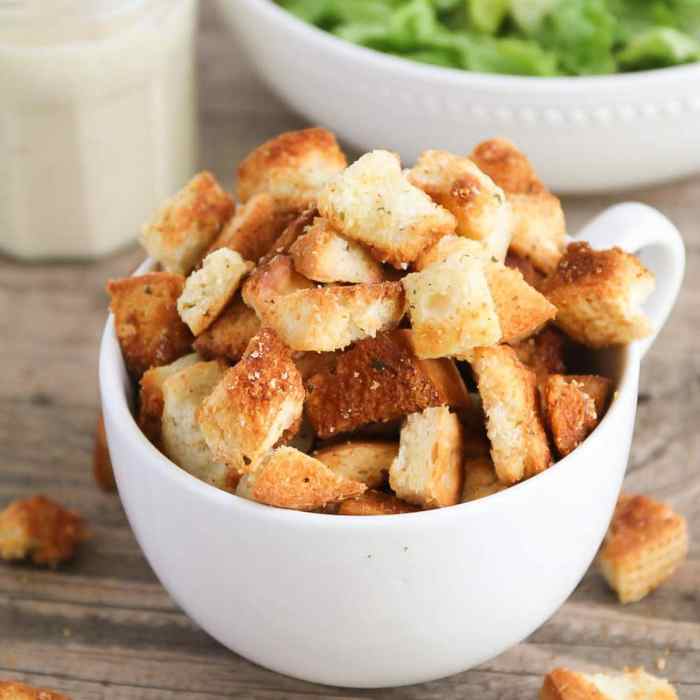
Repurposing old hamburger buns into croutons is a simple yet impactful way to reduce food waste and contribute to a more sustainable lifestyle. By giving these leftover buns a new life, we can minimize the environmental footprint associated with producing and discarding fresh bread.
Environmental Benefits of Repurposing Old Hamburger Buns
Repurposing old hamburger buns into croutons offers several environmental benefits:
- Reduces Food Waste:Instead of throwing away perfectly good buns, transforming them into croutons prevents them from ending up in landfills, where they decompose and release methane, a potent greenhouse gas.
- Conserves Resources:Making croutons from old buns reduces the need to produce fresh bread, which requires significant resources, including water, energy, and land for cultivation.
- Decreases Carbon Footprint:By reducing the demand for fresh bread production, we lower the overall carbon footprint associated with breadmaking, including transportation, packaging, and storage.
Environmental Impact of Crouton Making Methods
The environmental impact of making croutons can vary depending on the method used. Here’s a comparison of the environmental footprint of using old hamburger buns versus fresh bread for croutons:



